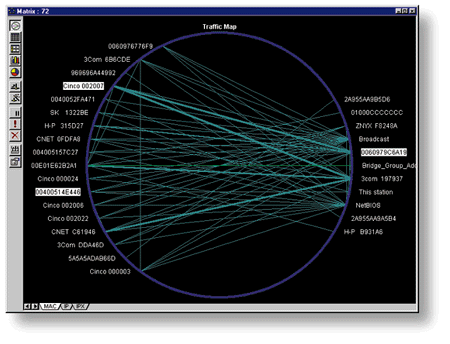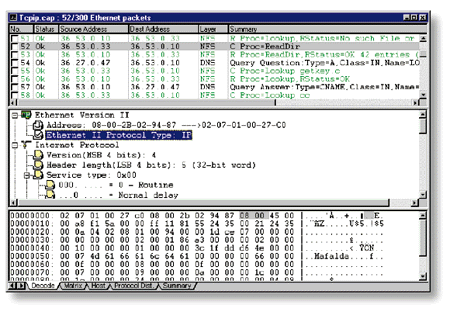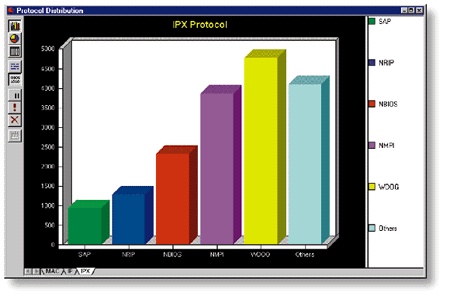Sniffer Basic A Cost-Effective, Real-Time Network Analysis and Monitoring Tool
Imagine having the ability to analyze and monitor every network segment in your organization, even small departmental LANs and remote branch offices. Or being able to put analysis and monitoring capabilities into the hands of every field service and network professional in your organization. The Sniffer Basic Protocol Analyzer and Network Monitor provides a cost-effective way to put analysis tools everywhere you need them.
The Sniffer Basic Analyzer is a software-based fault and performance management tool that captures data, monitors network traffic and collects key network statistics. Sniffer Basic was developed specifically for the 32-bit Windows operating system and Graphical User Interface. This tool enables network managers to extract and review vital and detailed information needed to effectively troubleshoot, manage and migrate today�s complex network environments. It is tailored to MIS staff supporting small businesses, remote offices and departmental networks, and is ideal for front-line IS personnel to monitor and troubleshoot common network problems.

Traffic Map provides a real-time graphical view of network conversations.
How Sniffer Basic Helps
Troubleshooting Sniffer Basic allows for quick troubleshooting of network problems.- Intuitive, consistent user interface allows for quick capture and display of data to monitor key network performance criteria
- Sniffer Basic data can be saved in Sniffer® Network Analyzer format for automated post-capture expert analysis and enhanced protocol interpretation
- Supports all major LAN topologies and decodes over 110 protocols from major protocol suites
- Sniffer Basic�s Traffic Map and traffic matrix show who is talking to whom
- Protocol distribution information allows you to see what protocols are in use, which IP applications are running, and which IPX transport processes are being utilized
- History reports enable understanding of network usage over long periods of time
- After establishing the network baseline, day-to-day utilization can be tracked to predict when changes will need to be made to accommodate increases in network traffic
Sniffer Basic Features
Windows Based Analysis and Monitoring Sniffer Basic was developed specifically for Windows 95 or NT and provides a state-of-the-art Graphical User Interface. This 32-bit software-based tool takes full advantage of the Windows operating environment. Running on standard Intel-based desktop and notebook computers, Sniffer Basic can simultaneously:- Capture data from one or more network interfaces
- Display previously captured data
- Generate traffic
- Monitor key network statistics
- Generate alarms as traffic thresholds are exceeded
- Automatically discover network hosts

Sniffer Basic utilizes the familiar Sniffer Network Analyzer 3-pane decode window.
LAN Architecture and Protocol Support
Sniffer Basic supports all major LAN topologies:
- Ethernet
- Fast Ethernet
- Token Ring
- 100-VG Any LAN
- Novell NetWare
- IP
- AppleTalk
- IBM/Microsoft
- SNA
- Banyan VINES
- XNS
- DECnet
Packet Capture and Real-Time Decodes
Sniffer Basic is capable of capturing all packets at near-wire speed. To help focus troubleshooting, filters can be quickly developed using standard Windows drag and drop functionality. Protocols are decoded and displayed in color-coded summary, detail, and hex windows.Sniffer Basic can capture data and write it to disk in real time. Sniffer Basic also provides integrated post-capture analysis and reporting capabilities.

Protocol distribution provides real-time analysis of protocols present on the network.
Sniffer Basic and Sniffer Network Analyzer
For complex problem resolution, captured data may be saved in the Sniffer Analyzer�s native trace file format for expert post-capture analysis and automatic identification of more than 200 commonly occurring network problems.Monitoring Network Statistics
Sniffer Basic provides real-time traffic analysis in tabular and graphical format, including pie and bar charts, traffic maps, plots and matrixes. Sniffer Basic can monitor multiple network statistics concurrently including utilization, packet rates, and error rates.The host table provides statistics for each network node including MAC, IP network, IP application, IPX network and IPX transport information. The traffic matrix provides a view of the traffic volume generated between pairs of nodes. The Traffic Map provides the user with a birds-eye view of network traffic patterns in real time. In addition to providing protocol distribution information for the major protocol suites, Sniffer Basic�s TCP/IP and IPX Protocol Distribution function provides a detailed breakdown of protocol usage within these suites.
History and Alarms
Sniffer Basic provides long-term traffic analysis in graphical format. It is capable of monitoring multiple network activities concurrently, allowing Network Managers to predict network needs and plan for them accordingly. Statistical data can be exported in CSV file format for further analysis in a database or spreadsheet.Alarms are generated and recorded anytime preset threshold parameters are exceeded. Information regarding network exception conditions that require immediate attention can also be sent to numeric beepers and alphanumeric pagers. Sniffer Basic can also send alarm information in email messages or SNMP traps.
Traffic Generation
Sniffer Basic�s traffic generator is a great tool for application developers and anyone else who needs to test network hardware and software components. Sniffer Basic will play back captured packets one at a time or in a batch. Individual packets may be edited before transmission. By varying the time delay between packets, Sniffer Basic can vary the amount of load placed on the network.Sniffer Basic also supports simultaneous traffic generation and packet capture.
Address Book and Auto Discovery
The Auto Discovery feature automatically "learns" IP domain names, IPX Login names, and NetBIOS names, and maps each to the proper MAC address. In addition, separate address books may be maintained for different network segments.Monitoring Multiple Segments
Network Managers can now gain visibility into every remote network from a central location using Distributed Sniffer Basic.Distributed Sniffer Basic provides the same intuitive user interface and feature set as Sniffer Basic. Additionally, this client/server application allows network managers to monitor multiple remote segments using software agents that communicate via IP to a central console. Agents can communicate with the console in-band or out-of-band. For more information on Distributed Sniffer Basic, see our Website at ngc.com.
Supported Protocols
| Ethernet: | DIX V2, IEEE 802.3, 802.2 LLC, SNAP, SNMP, BPDU |
| Token Ring: | IEEE 802.5 MAC, BPDU, LLC, SNAP |
| 100VG-AnyLAN: | IEEE 802.12 |
| VLAN: | IEEE 802.10, 802.1Q, Cisco ISL |
| Novell NetWare: | IPX, SPX, RIP, SAP, Echo, Error, NDIAG, NCP, NDS, LIP (Burst Mode), NWDOG, NBCAST, NLSP, Serialize, NetBIOS, SNMP |
| IP: | IPv4, IPv6, TCP, UDP, ARP, RARP, ICMP, IGMP, SNMP, SNMPv2, TFTP, FTP, TELNET, HTTP, HTTPS, SMTP, POP3, NNTP, BOOTP, DHCP, OSPF, RIP, RIPv2, EGP, GDP, IGRP, BGP, NetBIOS over TCP, DNS, RPC, NFS, LDAP, NWIP, IP-IN-IP, IPMOBIL, GREv2 |
| PPP: | CBCP, IPCP, LCP, CCP, NBFCP, CHAP, LQM, IPXCP |
| AppleTalk: | LAP, AARP, DDP, NBP, ATP, ZIP, RTMP, AEP, ADSP |
| IBM/Microsoft: | NetBIOS, NetBUEI, MB, SMB+ (CIFS), NMPI |
| SNA: | FID2, TH, RH, RU, DFC, SC, FMD/FMH, LU6.2 |
| Banyan VINES: | VLLC, VIP, VICP, VARP, VRTP, VIPC, VSPP, SMB |
| XNS: | IDP, SPP, Error, RIP, Echo, PEP |
| DECnet: | DRP, NSP, SCP, DAP, SMB, LAT |
| CPU: | Industry Standard Intel-based PC or Laptop with PC-Card (PCMCIA), ISA or PCI card slot. 80486 DX/66 minimum (Pentium 133MHz or better preferred). |
| Monitor: | 640x480, 16 color minimum 1024x768, 256 color preferred. |
| OS: | Windows 95 with 16MB RAM; Windows NT 4.0 with 24MB RAM CD-ROM drive required for installation. A minimum of 8MBs of available hard disk space is required. |